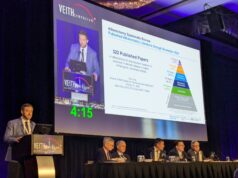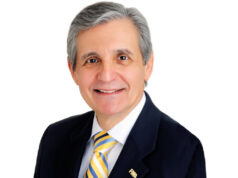
Reimbursement-per-procedure for femoropopliteal atherectomy and stenting has increased at about the same rate for national providers as a whole and vascular surgeons specifically—at the same time as much higher rates were recorded for radiologists and general surgeons, an analysis of Medicare reimbursement trends from 2012–2017 demonstrates.
The findings were presented by Matthew Haffner, MD, a general surgery resident at St. Barnabas Medical Center in Livingston, New Jersey, at the 2021 Vascular & Endovascular Surgery Society (VESS) winter annual meeting (Jan. 21-24), seeking to answer the question: Are high reimbursement amounts possibly incentivizing inappropriate medical provider care?
“Radiologists are making up an ever-increasing amount of overall providers that are accounting for an increasing amount of reimbursement—7% of providers accounting for 7% of reimbursement in 2012 to 10% providers accounting for 15% reimbursement in 2017—and the average radiologist performs significantly more procedures than any other profession,” Haffner told Vascular Specialist.
There is heightened focus on appropriateness in care among teams of investigators as well as at the level of Society of Vascular Surgery (SVS). Immediate past president Kim Hodgson, MD, made the issue a central focus of his presidency. VAM 2019 heard from Caitlin W. Hicks, MD, assistant professor of surgery at John Hopkins Medicine in Baltimore, about how new methodology had identified a significant number of physicians whose practice patterns might indicate failure to adhere to guidelines of care. Further research from Hicks et al followed at SVS ONLINE in 2020, revealing a higher use of atherectomy during peripheral vascular interventions among non-vascular surgery specialists and physicians working primarily in outpatient settings.
Haffner and colleagues probed the Medicare Provider Utilization and Payment database for femoropopliteal atherectomy and stent placement procedures carried out during the study period using the relevant current procedural terminology code.
He drew attention to raw numbers: In 2017 alone, he said, the procedure resulted in $120 million in reimbursements. In 2020, fempop atherectomy and stenting rates came in between $12,000–$20,000. And total Medicare reimbursement for the procedure across the study period was $480 million.
So, he asked: “Are there any trends in data for this procedure that could help explain its increased rate of reimbursement?” Vascular surgeons and cardiologists comprise the majority of Medicare reimbursement, he pointed out—but noted the relative increase in radiologist reimbursement. “On cursory analysis, the proportions of provider types seems to match with the proportion of medicare reimbursement,” Haffner explained.
“Radiology accounts for an increasing amount of Medicare reimbursement compared with the amount of provider percentage—7% of providers accounting for 7% of reimbursement to 10% of providers accounting for 15% reimbursement [over the study period]. The opposite is true for cardiology: 45% of providers accounting for 42% of reimbursement and 37% providers accounting for 29% of reimbursement.”
Haffner then probed whether there were relatively more radiologists performing the procedure—are radiologists performing more procedures?
“The amount of providers has more than doubled from 2012 to 2017,” he said. “The amount of procedures has more than doubled from 2012 to 2017 as well. Will the rate of increase in providers or procedures explain the increase in Medicare spending? It appears that this increased spending is not explained by simply more providers performing the procedure or more procedures being performed.”
The data show that the rate of increase in total providers and total procedures are closely related, Haffner pointed out—both showing a slower rate of increase compared with overall reimbursement.
“However, the proportion of provider types has changed over time,” he said. “Could this possible explain the increased spending? Perhaps if there is a relative increase in overall procedures performed by specialties that are reimbursed at higher rates and a relative decrease in those with lower rates on reimbursement.”
He then showed comparisons between the proportion of providers and the relative proportion of procedures performed by each specialty. This demonstrated no direct correlation between increased providers within a specialty and the amount of procedures that that specialty performs, Haffner said.
Regarding average procedures per provider, Haffner et al went on to compare individual specialties to the national average. This demonstrated that the average radiologist “is consistently performing more procedures than any other specialist,” he said, noting that the average vascular surgeon tends to perform the procedure approximately at or just below the national average rate.
The investigators posed another question: Are the reimbursement rates of individual specialists changing at different rates—and if this is the case, could it help explain some aspects of the overall increase in Medicare spending?
Haffner and colleagues returned to the overall rate of increase in Medicare reimbursement for femoropopliteal atherectomy and stenting—a relatively consistent increase over time.
“The rate of increase of vascular surgery reimbursement closely follows the national average rate of increase,” Haffner told the VESS meeting. “The rate of increase in reimbursement for cardiology is at a slower rate than the national average, and the rate of reimbursement for radiology and general surgery have increased at a rate much faster than the national average.”
Yet, rate of increase does not directly translate into an increased reimbursement rate, Haffner considered. Reimbursement rates by specialty showed that those surpassing or very close to the national average include vascular surgery, radiology and general surgery.
“Are there differences between the amount of interventions per patient between specialties?” Haffner and colleagues wondered. “Is this high reimbursement rate possibly incentivizing providers to perform more interventions on patients?”
Vascular surgeons have a relatively constant procedure rate per patient, they found, “whereas the other specialties tended to have more variability and higher overall procedures rates per patient.” The average cardiologist, the researchers noted, are consistently performing more procedures on the average patient than each year prior.
“With a reimbursement rate in excess of $8,000 per procedure, the temptation to overbill or over-perform procedures with monetary motivation may come into play within the billing process,” Haffner said.
But do the data bear aspects of this out?
“I chose the dividing line of 1.5 procedures per patient, as this would translate to equal to three interventions on two people,” he explained. “This number represents the annual average. Being as this intervention can only be performed two times on one person at a time, it seemed a decent starting point to look for discrepancies within the data.”
After 2013, the researchers found, vascular surgeons—”who are arguably the specialty that would or should be called upon for the more challenging cases that have a higher likelihood of multiple interventions”—have a much lower percentage of providers with intervention rates greater than or equal to 1.5 when compared with the national average, radiologists and general surgeons. “So while vascular surgeons are performing less than the national average of interventions per patient, they still account for an increasing amount of total procedures,” Haffner added.
Commenting further on the findings, Haffner told Vascular Specialist: “I believe I demonstrated some rough patterns of change within Medicare reimbursement for this procedure that showed areas of possible concern moving forward, both from an overall Medicare perspective and a vascular surgery perspective.
“With the current environment of procedure reimbursement, the elevated rates of reimbursement for more specialized surgeons—including vascular surgeons—and the rapid increase in Medicare spending in general, it is reasonable that areas that can potentially decrease inappropriate Medicare spending will be investigated more fully moving forward.”












